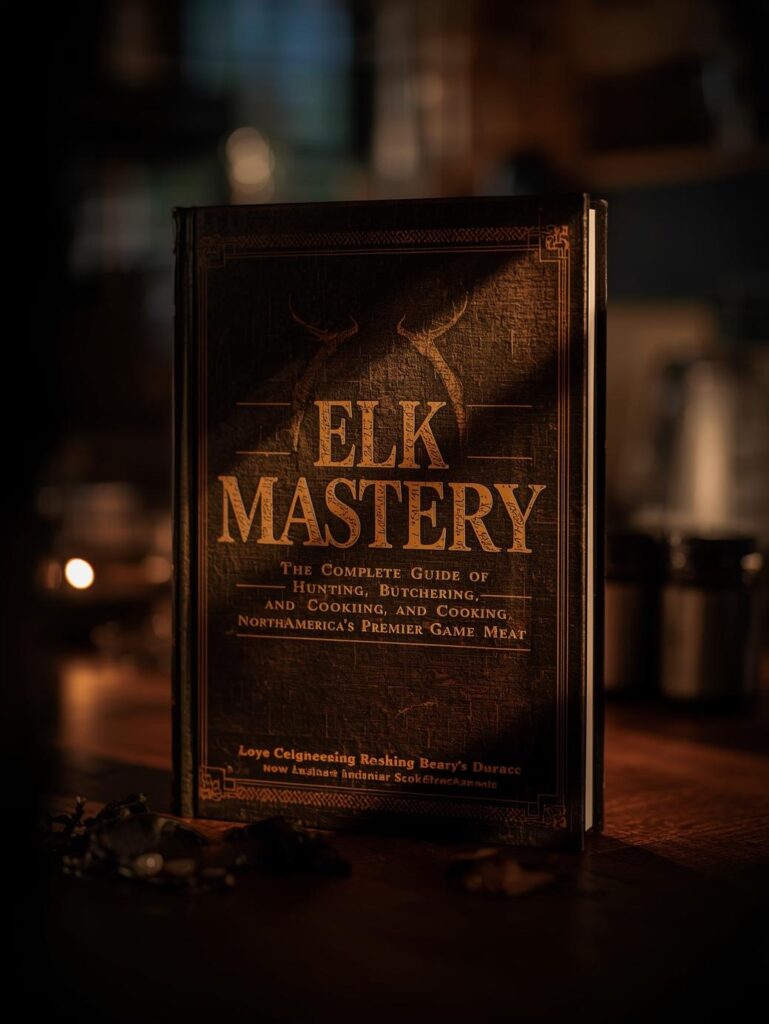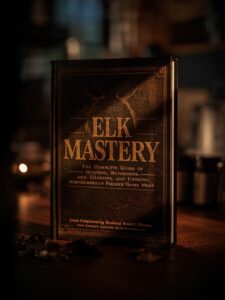The King of Game Meat: Elk isn’t just venison’s bigger cousin—it’s the pinnacle of wild game, offering the perfect balance of leanness, flavor, and tenderness. Where whitetail can be intensely gamey and moose can be challenging to cook, elk sits in the sweet spot: robust enough to be interesting but refined enough for the finest dining. This is the protein that turns game skeptics into believers and elevates the hunter into a gourmet.
Elk Mastery: The Complete Guide to Hunting, Butchering, and Cooking North America’s Premier Game Meat
“Elk is the aristocrat of the wild—a meat that carries the dignity of the mountains in every bite. It has the leanness of bison but with a finer grain, the richness of beef but with cleaner finish, and the wild character of venison but without the intensity. Cooking elk isn’t about taming something wild; it’s about revealing something already perfect. Treat it with respect, cook it with precision, and it will reward you with the most sublime eating experience the wilderness has to offer.”
Elk Mastery: The Complete Guide to Hunting, Butchering, and Cooking North America’s Premier Game Meat
Download Our Elk Mastery Guide - Field Care, Butchering & Cooking Times
Elk meat represents the holy grail for game enthusiasts—lean, protein-packed, and incredibly flavorful without being overpowering. But many hunters and cooks treat elk like oversized deer, missing the nuances that make this majestic animal truly special. From field care that preserves its delicate flavor to cooking techniques that honor its leanness, this guide will transform your approach to elk, ensuring every steak, roast, and burger reaches its full potential.
🎯 ELK VS. VENISON: THE GAME MEAT HIERARCHY
Understanding why elk stands above other game meats is the first step to mastery.
🦌 ELK PROFILE
- Flavor: Mild, slightly sweet, clean finish
- Texture: Fine-grained, tender, firm
- Fat Content: 2-4% (very lean)
- Color: Deep ruby red
- Gameyness: Low to moderate
🦌 WHITETAIL DEER PROFILE
- Flavor: Strong, distinctly gamey, robust
- Texture: Coarser grain, can be tough
- Fat Content: 3-5% (lean)
- Color: Dark red to brownish
- Gameyness: Moderate to high
🔪 THE ELK BUTCHER’S ROADMAP
Proper butchering makes the difference between good elk and great elk.
🎯 Elk Cut Masterclass
🎯 Maximizing Your Elk Harvest
| Cut | Description | Best Cooking Method | Target Temp | Yield from Bull Elk |
|---|---|---|---|---|
| Backstrap | Prime tenderloin muscle | Grill, pan-sear, roast | 125-135°F (med-rare) | 8-12 lbs |
| Tenderloin | Inside loin, most tender | Quick sear, butter baste | 120-130°F (rare-med rare) | 3-5 lbs |
| Round/Rump | Large hindquarter muscles | Roast, London broil, grind | 130-140°F (med-rare) | 25-35 lbs |
| Ribs | Lean, flavorful between bones | Braise, slow smoke | 180-195°F (well-done) | 8-12 lbs |
| Neck & Shoulder | Tough, collagen-rich | Braise, stew, grind | 180-195°F (well-done) | 15-25 lbs |
| Shanks | Gelatin-rich, bone-in | Braise (osso buco), slow cook | 180-195°F (well-done) | 6-10 lbs |
🌡️ THE ELK TEMPERATURE DICTATE
Elk’s leanness means there’s zero margin for overcooking.
⚡ The Elk Doneness Commandments
With No Marbling to Protect You, Precision is Everything
- Rare (120-125°F): Cool red center. For premium cuts only—maximum juiciness.
- Medium-Rare (125-135°F): PERFECTION ZONE. Warm red center. Ideal for steaks, chops, and roasts.
- Medium (135-145°F): Warm pink center. Acceptable but moisture loss begins.
- Medium-Well (145-155°F): Slightly pink. Significant dryness and toughness developing.
- Well-Done (160°F+): Gray throughout. ABSOLUTE DISASTER for steaks. Reserve only for ground meat or slow-cooked dishes. Temperature guide here.
🔥 THE TWO ELK COOKING PHILOSOPHIES
Choose your path based on the cut and desired outcome.
⚡ HOT & FAST
For Premium Cuts (Backstrap, Tenderloin, Steaks)
- Goal: Quick sear, preserve juices
- Method: High heat grill or pan, 2-4 minutes per side
- Temperature: Rare to medium-rare ONLY
- Key: Bring to room temp first; don’t move while searing
- Result: Juicy, tender, clean elk flavor
🐢 LOW & SLOW
For Tough Cuts (Neck, Shank, Shoulder)
- Goal: Break down connective tissue
- Method: Braise, stew, slow roast with liquid
- Temperature: 180-195°F until fork-tender
- Key: Use acidic cooking liquids; add fat
- Result: Falling-apart tender, rich flavor
🎯 GRILLED ELK BACKSTRAP: THE ULTIMATE SHOWCASE
When treated right, elk backstrap is one of the finest meats on earth.
👨🍳 Perfect Elk Backstrap in 20 Minutes
The Crown Jewel of Wild Game
- Step 1: Preparation: Remove silver skin completely. Cut into 1.5-2 inch thick medallions. Bring to room temperature.
- Step 2: Seasoning: Pat dry. Season aggressively with salt and pepper just before cooking. Consider a coffee-chili rub for depth.
- Step 3: High Heat Sear: Get grill or cast iron screaming hot (500°F+). Brush meat with oil, not the cooking surface.
- Step 4: Cook 2-3 Minutes Per Side: Develop a deep brown crust. Don’t move until ready to flip.
- Step 5: Temperature Check: Start checking at 2 minutes per side. Pull at 125°F for medium-rare.
- Step 6: Butter Bast (Optional but Recommended): Add butter, garlic, and rosemary to pan. Spoon over meat during last minute.
- Step 7: Rest Critically: Rest for 5-8 minutes. Temperature will rise to 130-135°F. Resting science here.
- Step 8: Slice & Serve: Slice against the grain. Serve immediately.
🧪 THE FLAVOR ENHANCEMENT MATRIX
Elk’s mild flavor welcomes enhancement without being overwhelmed.
🎯 Elk Flavor Pairing Guide
Building Bridges to Elevate Natural Flavors
- Woody & Earthy: Rosemary, thyme, sage, mushrooms, juniper berries. Classic pairings that complement without overpowering.
- Sweet & Fruity: Cherry reduction, blackberry sauce, port wine glaze, apple compote. Sweetness balances the lean savoriness.
- Smoky & Robust: Smoked salt, chipotle, bacon wrapping, coffee rubs. Adds depth and complexity to the mild flavor.
- Bright & Acidic: Balsamic glaze, red wine reduction, citrus zest. Cuts through the leanness and adds vibrancy.
- Fat Addition: Since elk has minimal fat, add it externally. Cook in bacon fat, serve with compound butter, or wrap in prosciutto.
🚨 ELK TROUBLESHOOTING: FIX COMMON MISTAKES
🎯 Elk Cooking Rescue Guide
| Problem | Cause | Immediate Fix | Prevention |
|---|---|---|---|
| Tough & Chewy | Overcooked | Slice very thin against grain; use in stir-fry or salad | Use thermometer; pull at 125°F; never cook beyond medium |
| Dry & Grainy | Overcooked + no added fat | Dice and use in chili or shepherd’s pie with extra liquid | Cook to rare/medium-rare only; baste with butter or oil |
| Lacks Flavor | Underseasoned, mild preparation | Serve with flavorful sauce or compound butter | Be generous with salt; use rubs or marinades |
| Too Gamey | Poor field care, older animal | Serve with bold sauces; use in heavily spiced dishes | Quick field dressing; proper aging; choose younger animals |
| Burnt Outside, Raw Inside | Heat too high, cut too thick | Finish in 375°F oven until target temp reached | Use two-zone cooking; reverse sear for thick cuts |
🏔️ FIELD & AGING: THE FOUNDATION OF FLAVOR
Elk quality is determined in the first hours after harvest.
🔬 The 5 Pillars of Elk Field Care
- Quick Field Dressing: Gut within 45-60 minutes. Remove reproductive organs carefully to prevent tainting.
- Rapid Cooling: Get body cavity cooling immediately. In warm weather, prop open with sticks.
- Proper Hanging: Hang in cool environment (34-38°F) for 7-14 days. This aging tenderizes and develops flavor.
- Dry Aging vs Wet Aging: Dry aging (unwrapped) develops more flavor but requires controlled conditions. Wet aging (vacuum sealed) is more practical for most hunters.
- Butchering Timeline: Process within 2 weeks for optimal quality. Freeze immediately after processing. Butchering guide here.
🏁 THE MOUNTAIN’S BOUNTY, PERFECTED
Elk is more than just meat—it’s a connection to the wilderness, a reward for skill and patience, and proof that the finest foods often come from the most pristine places. Cooking elk will make you a better cook by teaching you precision, the importance of temperature control, and how to enhance rather than overpower natural flavors.
When you serve a perfectly grilled elk backstrap with a cherry port reduction, or a slowly braised shank that falls apart at the touch of a fork, you’re not just serving dinner—you’re sharing an experience. You’re offering a taste of the high country, the crisp mountain air, and the majesty of one of North America’s most magnificent animals.
Respect the animal with proper field care. Honor the meat with precise cooking. Share the experience with those who appreciate the extraordinary. This is elk mastery.
Deepen your expertise with our complete guide to cooking all game meats
No posts selected. Please provide either "slugs" or "ids" parameter.
Continue Your Game Meat Journey: Expand your wild protein expertise with these guides.



